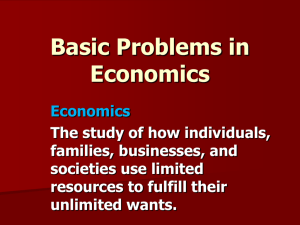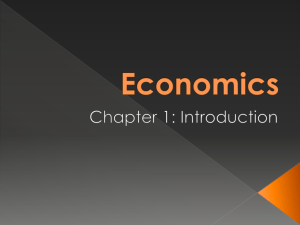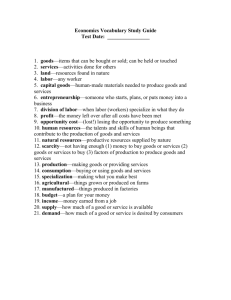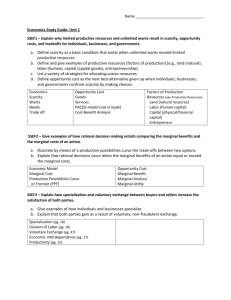UNIT I: INTRODUCTION TO THE ECONOMIC PROBLEM UNIT 1
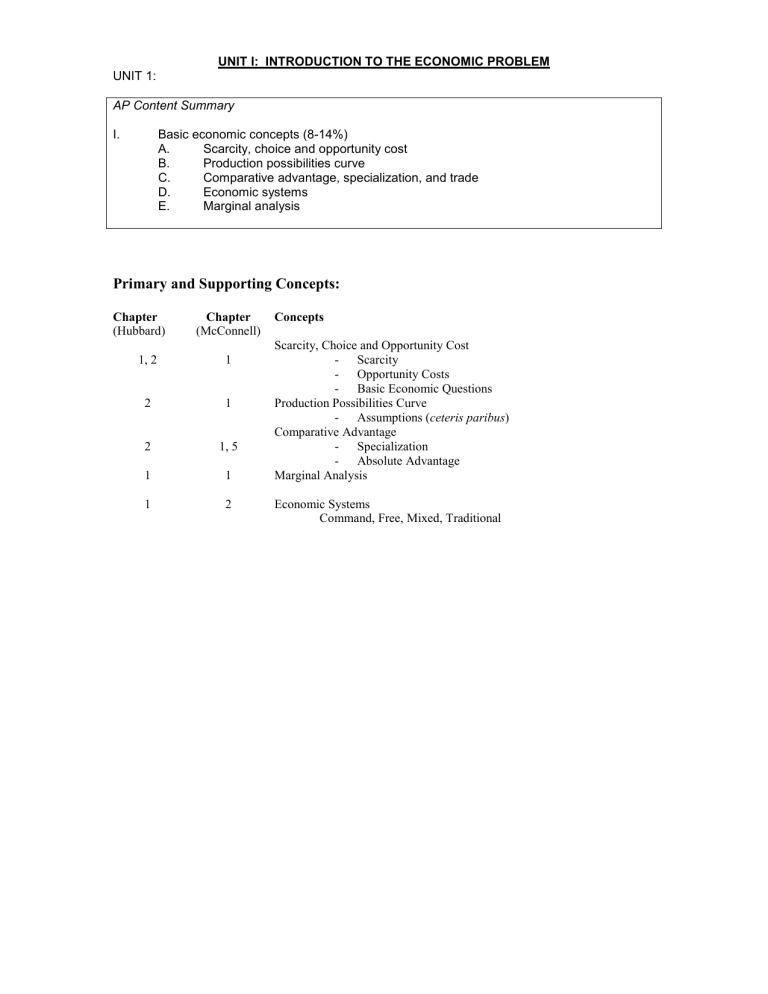
UNIT I: INTRODUCTION TO THE ECONOMIC PROBLEM
UNIT 1:
AP Content Summary
I. Basic economic concepts (8-14%)
A.
B.
Scarcity, choice and opportunity cost
Production possibilities curve
C.
D.
E.
Comparative advantage, specialization, and trade
Economic systems
Marginal analysis
Primary and Supporting Concepts:
Chapter
(Hubbard)
1, 2
Chapter
(McConnell)
1
Concepts
2
2
1
1
1
1, 5
1
2
Scarcity, Choice and Opportunity Cost
Scarcity
Opportunity Costs
Basic Economic Questions
Production Possibilities Curve
Assumptions ( ceteris paribus )
Comparative Advantage
Specialization
Absolute Advantage
Marginal Analysis
Economic Systems
Command, Free, Mixed, Traditional
Topic 1:
Scarcity, Choice, and Opportunity Cost and Marginal Analysis
Read: Hubbard pages 2-6, 10-15,34-40
* Review graphs and charts on pages 22-30
Objectives:
1. Define economics , distinguish between microeconomics and macroeconomics, and explain the questions economics tries to answer.
2. Describe the “economic way of thinking,” including definitions of scarcity, utility, opportunity costs, marginal costs, marginal benefits and how these concepts may be used in decision-making.
3. Identify types of economic resources and types of income associated with various factors.
4. Explain and give examples of the fallacy of composition, post hoc fallacy, and other logical pitfalls.
Concepts to memorize:
Scarcity
Marginal
Microeconomics
Positive Economics
Factors of Production
Interest
Inputs/Outputs
Opportunity Cost
Economic Principle
Macroeconomics
Normative Economics
Wage
Profit
Goods/Services
Utility ceteris paribus
Aggregate
Incentive
Rent
Rational Choice
Key Conceptual Questions:
1. What is scarcity?
2. What are three questions every society must answer because of scarcity?
3. What are economic resources? What categories do economists use to classify them?
Why are resources also called factors of production ? Why are they called inputs ?
4. Specify and explain the typical shapes of the marginal-benefit and marginal-cost curves. How are these curves used to determine the optimal allocation of resources to a particular product? If current output is such that marginal cost exceeds marginal benefit, should more or fewer resources be allocated to this product? Explain.
Topic 2:
Production Possibilities:
Read: Hubbard pages 34-40
Objectives:
1. Construct a production possibilities curve when given appropriate data.
2. Illustrate economic growth, unemployment and underemployment of resources, and increasing costs using a production possibilities curve.
3. Define efficiency and describe an efficient use of resources.
Concepts to memorize:
Budget Line
Trade-off
Productive Efficiency
Attainable/Unattainable
Economic Growth
Allocative Efficiency
PPF
Efficiency
Free Lunch
Key Conceptual Questions:
1.
In what ways and to what extent does the production possibility model (diagram) illustrate the fundamental economic problems facing all societies?
2.
Illustrate on a PPF model economic growth.
Topic 3:
Economic Systems
Read: Hubbard pages 7-10 and pages 46-53
Objectives:
1. Highlight the main features of a market economy and a command economy.
2. List and explain the important characteristics of the American market system.
3. Explain the role of self-interest and “invisible hand” in promoting economic efficiency.
4. Explain the limitations of command economies.
5. Identify the decision makers and the markets in a market system using the circular flow diagram.
6. Identify the two roles each that households and businesses play using the circular flow diagram.
7. Differentiate between product and resource markets.
Concepts to memorize:
Traditional
Mixed
Command
Invisible Hand
Goods and Services Market Factor Market
Firm
Free Market
Curricular Flow Model
Households
Key Conceptual Questions:
1. Define the four types of economies.
2. Describe the characteristics of a Free Market Economic System.
3. Describe who and how goods and services are allocated in a free market system.
4. Identify and describe the elements that make up the circular flow model.
Topic 4:
Absolute and Comparative Advantage:
Read: Hubbard pages 40-45
Objectives:
1.
Define and calculate absolute and comparative advantages for production and exchange.
2.
Explain how people gain from specialization and trade.
3.
Predict the effects of policies that restrict free trade.
Concepts to memorize:
Comparative Advantage Absolute Advantage Specialization
Key Conceptual Questions:
1. Why do people trade?
2. How would trade restrictions affect the welfare of individuals and/or nations?




